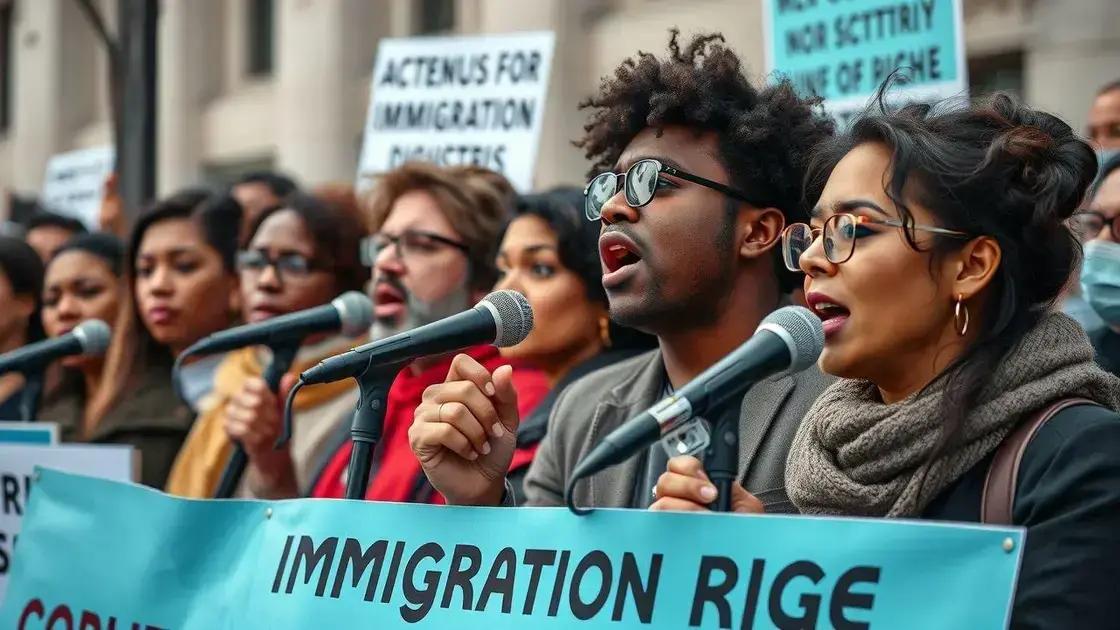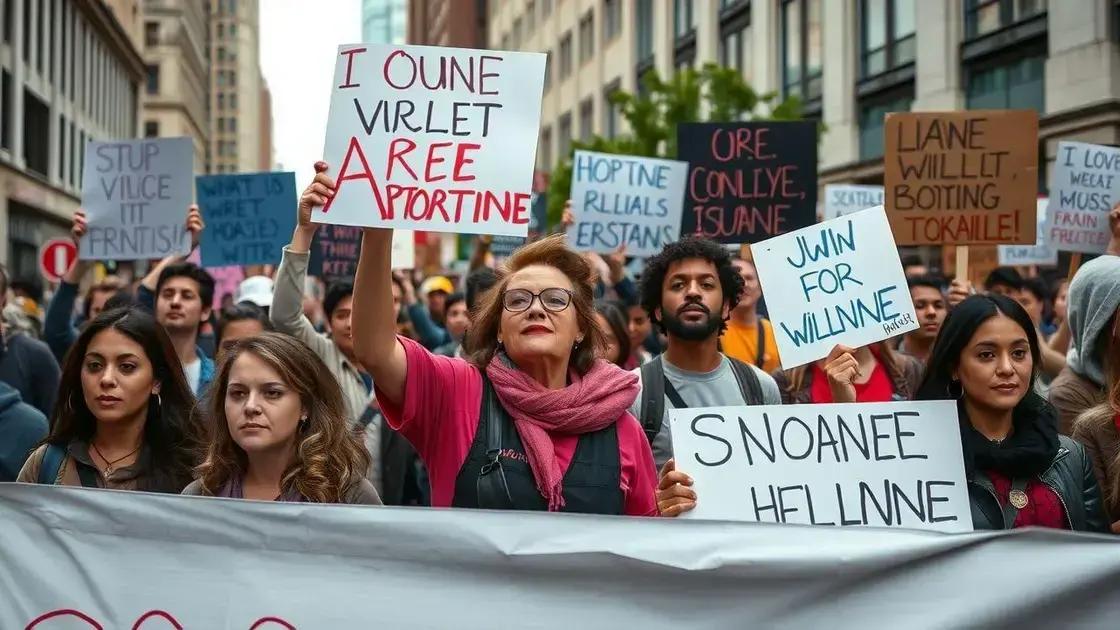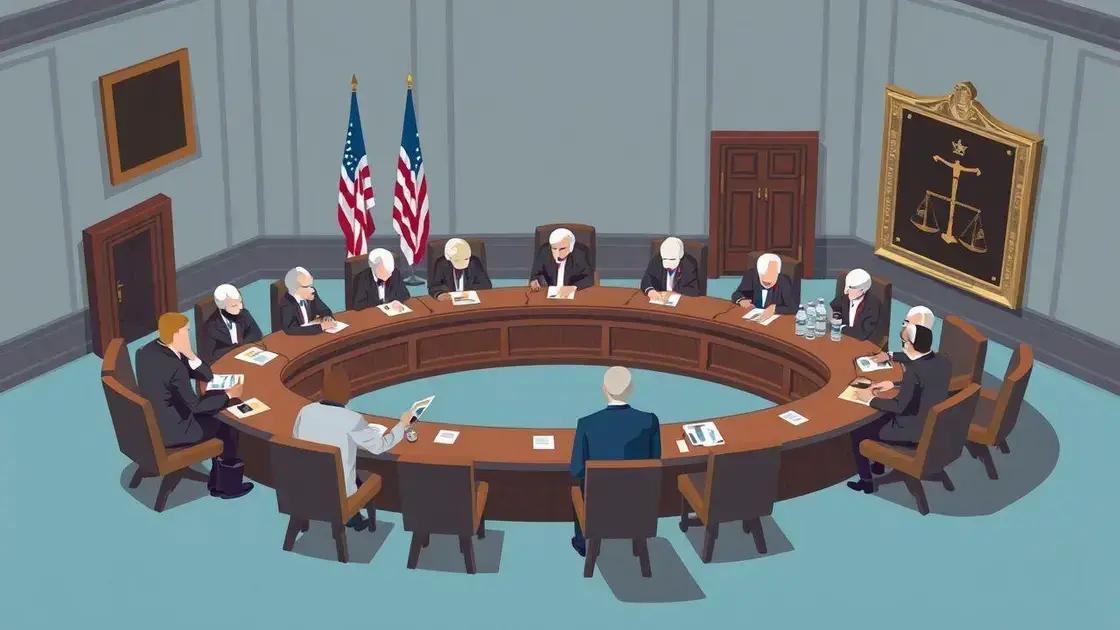Immigration rights demonstrations escalate in April 2025

Anúncios
The immigration rights movement has escalated in April 2025, with protests highlighting demands for fair treatment, government engagement, and the positive impact on local communities amidst varying responses from officials.
Immigration rights demonstrations escalate in April 2025, capturing attention across the nation. As tensions rise, have you noticed how these events are affecting everyday lives? Let’s delve into the heart of these movements.
Anúncios
The rise of immigration rights movements
The rise of immigration rights movements has been a significant trend in recent years, particularly as people come together to advocate for change. This movement has gained momentum due to various factors, including increasing awareness of social issues and the desire for equitable treatment for all individuals, regardless of their immigration status.
Factors Contributing to the Movement
One of the primary reasons the immigration rights movement has grown is the visibility of the struggles faced by immigrants. Stories shared on social media and news outlets create a deeper understanding of their challenges. Furthermore, many people are advocating for policies that promote justice and equality.
Anúncios
- Rising deportation rates
- New legislation targeting immigrant communities
- Public protests and support networks
- Increased access to information about rights
Another aspect fueling this rise is the unity among diverse groups. Individuals from various backgrounds are recognizing their shared experiences and coming together for a common cause. Many organizations play a crucial role in facilitating these connections, providing resources and support to those affected.
Key Events in Recent Years
Events such as large-scale protests and community gatherings have had a profound impact on public awareness. For instance, rallies advocating for immigrant rights have not only highlighted the issues but also demonstrated the strength of solidarity among communities.
- Annual marches advocating for comprehensive immigration reform
- Community town halls discussing local immigrant issues
- Collaborations with other social justice movements
As the movement continues to grow, the message of unity and justice becomes increasingly clear. The rise of immigration rights movements not only supports those seeking a better life but also enriches the broader society by advocating for human rights.
Key events of April 2025
In April 2025, a series of key events surrounded the immigration rights movement, sparking significant attention from the public and media. These events have highlighted the ongoing challenges faced by immigrant communities and the increasing urgency of their demands for fair treatment.
Major Demonstrations
One of the most notable occurrences was a massive demonstration that took place in major cities across the country. Thousands of people gathered to voice their support for immigration reform and to stand against harsh policies affecting immigrants.
- Demonstrations in Washington, D.C. drew national media coverage.
- Cities like Los Angeles and New York saw record turnout.
- Speakers included prominent activists and community leaders.
- Messages focused on unity and solidarity among diverse groups.
During these demonstrations, community members shared personal stories, illustrating the impact of immigration policies on their lives. Many were inspired by the courage shown by their peers, leading to more people joining the movement.
Community Outreach Initiatives
In addition to protests, various outreach initiatives were organized. Community centers and local organizations provided resources, including legal assistance and educational programs. These initiatives aimed to empower immigrants and raise awareness about their rights.
- Workshops on legal rights for immigrants.
- Information booths distributing flyers and resources.
- Collaborations with local universities for educational events.
- Social media campaigns to share personal stories.
These efforts served to inform immigrants about available support services and foster a sense of community. As more people became aware of these resources, the feeling of hope and empowerment grew.
Political Responses
Political leaders also began to take notice. In some cases, elected officials expressed support for the movement, while others pushed back against the changes being demanded. This tension between advocates and policymakers became a focal point of discussion throughout the month.
As April 2025 unfolded, the events highlighted the resilience of the immigration rights movement. The collective actions and stories shared by individuals only strengthened the call for a more just and equitable society.
Voices of the demonstrators

The voices of the demonstrators play a crucial role in the immigration rights movement. Each individual brings their own unique story, experiences, and hopes for the future. As people gather in marches and protests, their voices unite to amplify the call for justice and change.
Personal Stories
Many demonstrators share personal anecdotes that resonate with the crowd. These stories often highlight the challenges faced by immigrant families, from detention to the fear of deportation. By sharing their struggles, they humanize the issue and foster empathy among supporters.
- Stories of families separated due to deportation.
- Experiences of navigating legal systems.
- Challenges in accessing education and healthcare.
- Hope for a better future for their children.
Listening to these narratives encourages discussion and builds a sense of community. It reminds attendees that they are not alone in this fight and that their struggles are part of a larger movement.
Empowerment through Speech
Public speaking has become a powerful tool for advocates. Many activists circle back to the importance of sharing their truths. Platforms for speaking allow individuals to express their frustrations and aspirations openly. Through speeches and open mic sessions, demonstrators ignite passion within the crowd.
Moreover, these speeches often include calls to action. Demonstrators encourage others to get involved, reminding them that every voice counts. By tapping into the collective energy of the group, speakers inspire others to join the cause and make a difference.
Building Community Solidarity
The shared experience of standing together fosters a strong sense of solidarity among demonstrators. As they chant slogans and wave banners, the feeling of unity grows. They are not just advocating for themselves but for all those who face similar challenges.
This camaraderie reinforces the idea that the fight for immigration rights is not solely an individual battle but a collective effort. The voices raised in unison create a powerful atmosphere of hope and determination that resonates through the streets.
Impact on local communities
The impact on local communities due to the immigration rights movement has been profound. As more people engage in advocacy, communities experience both challenges and positive changes. These events increase awareness of immigration issues and foster a sense of unity among residents.
Economic Contributions
Immigrant communities play a vital role in local economies. They bring diverse skills and perspectives that can enhance local businesses. Many immigrants start their own businesses, contributing to job creation and the local tax base.
- Growth in local entrepreneurship and small businesses.
- Diversification of local markets and services.
- Community investments and improvements.
- Increased employment opportunities for residents.
As local economies thrive, the benefits extend to everyone in the community, promoting growth and stability. This positive economic impact often leads to greater community support for immigration rights.
Cultural Enrichment
Another significant effect is cultural enrichment. The immigration rights movement brings together diverse voices, customs, and traditions, making communities more vibrant. Events like festivals and cultural celebrations highlight this diversity and foster appreciation for differing backgrounds.
- Sharing of cultural traditions and practices.
- Increased access to multicultural events.
- Greater understanding and respect among residents.
- Creation of community spaces to celebrate diversity.
As these cultural exchanges happen, they promote solidarity and understanding among various groups. Community members begin to engage in conversations that lead to deeper connections.
Social Challenges
Despite these positive changes, there are also challenges. The immigration rights movement can sometimes lead to tensions within communities, particularly when people have differing opinions on immigration policies. Some residents may feel threatened or unsure about the changes happening around them.
However, these challenges can also lead to important discussions. As communities work through their differences, they often find common ground and build a stronger foundation for cooperation. Grassroots initiatives often emerge, encouraging dialogue and fostering relationships across cultural lines.
Ultimately, the impact of the immigration rights movement on local communities underscores the importance of unity and understanding. As more individuals participate in this movement, communities can adapt, grow, and thrive.
Government response to escalating protests
The government response to escalating protests regarding immigration rights has varied significantly, reflecting the complex dynamics between public sentiment and political action. As demonstrations grew larger and more organized, officials were faced with increasing pressure to address the concerns being raised.
Initial Reactions
Initially, many local governments chose to acknowledge the protests without committing to substantial changes. Some officials expressed support for the rights of demonstrators while emphasizing the need for law and order. This cautious approach often included public statements that recognized the passion of the protesters but also highlighted the challenges of implementing wide-ranging reforms.
- Calls for maintaining public safety during protests.
- Public statements supporting peaceful assembly and dialogue.
- Commitments to reviewing current immigration policies.
While these responses indicated a willingness to listen, many activists felt they fell short of addressing the urgent needs of immigrant communities.
Legislative Proposals
As protests intensified, some lawmakers proposed new legislation aimed at reforming application processes and protections for immigrants. This included efforts to provide pathways to legal residency for undocumented individuals and to protect vulnerable groups from deportation.
However, the political environment remained polarized. While some legislators pushed for progressive reforms, others resisted changes, arguing that current immigration policies should remain intact. This division created significant debate at both state and national levels, often leading to heated discussions and protests in government buildings.
Community Engagement
In response to public demands, many government officials began to engage more directly with community leaders and activists. Town hall meetings and listening sessions were organized to open dialogue and better understand the needs of immigrants.
This engagement aimed to foster trust between government representatives and the communities. Officials learned about real-life experiences, which helped shape more informed policy decisions. However, the effectiveness of these engagements often depended on local political climates and individual officials’ willingness to act.
Law Enforcement Practices
Another aspect of the government’s response included adjustments in law enforcement practices during protests. Some areas implemented policies aimed at de-escalating tensions, while others faced criticism for excessive force.
This inconsistency highlighted the need for training and policy reform in law enforcement regarding how they handle protests related to immigration rights, ensuring that demonstrators were treated with respect and dignity. Observers called for transparency and accountability in law enforcement actions during these events.
Overall, the government’s response to escalating protests reflected a complex interplay between political pressure and the necessity for meaningful change. As public engagement grew, so did the expectations for a more proactive and supportive approach to immigration rights.
FAQ – Frequently Asked Questions About Immigration Rights Protests
What are the main goals of the immigration rights movement?
The main goals include advocating for fair immigration policies, protecting vulnerable populations, and raising awareness about the challenges immigrants face.
How can I get involved in immigration rights demonstrations?
You can join local organizations, participate in community meetings, and attend protests to support the cause. Staying informed and spreading awareness is also helpful.
What impact do immigration protests have on local communities?
These protests often unite community members, raise awareness of immigration issues, and encourage positive dialogue between residents and local officials.
How does the government typically respond to immigration protests?
Government responses vary from public support and proposed legislation to law enforcement adjustments aimed at ensuring safety during protests.






